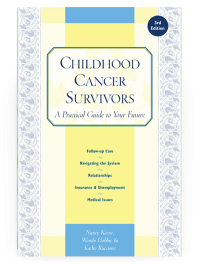Childhood Cancer Survivors
Sun exposure
Skin cancer is very common, but your likelihood of getting it is, to an extent, in your control. Most skin cancers are caused by exposure to the sun. A lifetime of tans and burns increases your cancer risk and can also cause wrinkles and brown spots on your skin. Hazards of overexposure to the sun include:
-
Skin cancer. The risk of skin cancer increases the more your skin is exposed to sunlight or UV (ultraviolet) light from sun lamps, especially in areas that received radiation. Most skin cancers can be removed, but they can be life-threatening if not diagnosed and treated early.
-
Sunburns. These can occur to both skin and eyes.
-
Premature skin aging. Years of overexposure to the sun can result in dry, wrinkled, and leathery skin.
-
Cataracts. The risk of developing cataracts is increased by long-term exposure to the sun’s UVB (ultraviolet B) rays.
I’m not a sun buff, that’s for sure. I think having cancer is the reason why. Why tempt fate? If I go out, I always put sunscreen on. But mostly I just limit my exposure.
Those at highest risk for damage from the sun are people with fair skin, blond or red hair, and blue eyes. However, anyone can be damaged by excessive exposure to the sun or to the lights used in tanning beds or booths. In addition, any skin that has been irradiated is at risk for developing skin cancer. You can prevent these problems by:
-
Limiting the amount of time you are in the sun, especially during the middle of the day. Sun exposure at high altitudes and in places near the equator increases your exposure to harmful rays.
-
Wearing sunscreen with an SPF (sun protective factor) of 15 or higher. It should be applied at least 30 minutes before going outdoors and periodically throughout the day. Wear sunscreen even on cool or cloudy days, especially if you are around surfaces such as snow or water that reflect the sun’s rays. If you have acne, use an alcohol-based and non-waterproof product.
-
Covering your skin (especially irradiated areas) with clothing, sunglasses, or hats.
-
Avoiding tanning beds or booths. The UVA (ultraviolet A) light used in these places damages the skin.
When you use sunscreen, you may not absorb enough vitamin D. Therefore, it is a good idea to make sure you take a vitamin D supplement ( www.nlm.nih.gov/medlineplus/druginfo/natural/929.html ). Also, routinely check any areas of skin that were irradiated and ask someone else to check areas you can’t see well. If you have numerous moles, see a dermatologist on a regular basis. If you develop any of the following symptoms, bring them to the attention of your healthcare provider:
-
A bump or mole that has different colors rather than being a uniform color
-
A bump or mole that changes size or bleeds
-
A bump or mole that is red or sore
-
Any freckling or color changes in the skin
In addition, some medicines, foods, and cosmetics may increase your sensitivity to sunlight.
Table of Contents
All Guides- 1. Survivorship
- 2. Emotions
- 3. Relationships
- 4. Navigating the System
- 5. Staying Healthy
- 6. Diseases
- 7. Fatigue
- 8. Brain and Nerves
- 9. Hormone-Producing Glands
- 10. Eyes and Ears
- 11. Head and Neck
- 12. Heart and Blood Vessels
- 13. Lungs
- 14. Kidneys, Bladder, and Genitals
- 15. Liver, Stomach, and Intestines
- 16. Immune System
- 17. Muscles and Bones
- 18. Skin, Breasts, and Hair
- 19. Second Cancers
- 20. Homage
- Appendix A. Survivor Sketches
- Appendix B. Resources
- Appendix C. References
- Appendix D. About the Authors
- Appendix E. Childhood Cancer Guides (TM)

